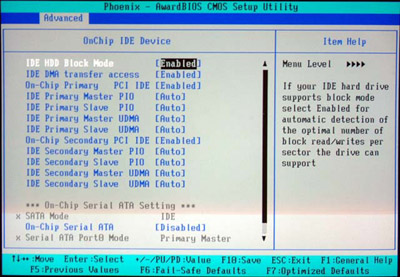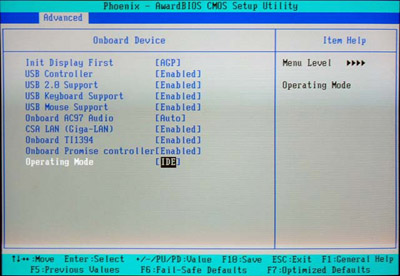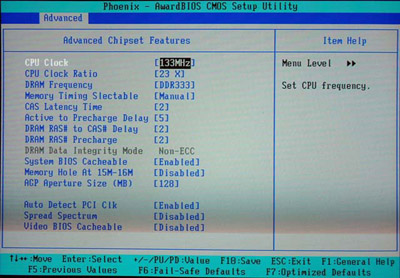Asus PC-DL Deluxe: 875 with Dual Xeons
by Wesley Fink on September 6, 2003 12:06 AM EST- Posted in
- Motherboards
Asus PC-DL: BIOS and Overclocking
Asus uses Award BIOS in the “drop-down menu” arrangement found on many Asus boards. If you’re familiar with the Asus implementation of Award and AMI BIOS on their other motherboards, then you will be very comfortable with the BIOS arrangement. It’s a little different than the more common Award arrangement, but all the information and choices are there — they’re just arranged a little differently.
Menu choices are across the top and as you navigate across, the dropdown menu’s change. Many of the menus that are standalone in traditional Award BIOS are nested under other headings here.

The Advanced menu provides access to 3 sub-menus for adjusting IDE-SATA and other on-Chip devices and ports.

The On-Chip IDE device section is where adjustments are made to IDE, and where Serial ATA and SATA RAID are setup.

Onboard Device provides control options for USB, audio, CSA LAN, firewire, and the Promise controller.

Memory timings, FSB, and Multiplier Ratios are adjusted in the Advanced Chipset Menu. Our Xeons allowed multiplier adjustment down, but we did not have options to set values higher than the stock 23X.

CPU FSB can be adjusted from stock 133 to 165, but there are no adjustments for Voltage or a “Fixed PCI/AGP” setting. This severely limits overclocking of the Dual-Xeon board.

Asus is well-known for their power control and adjustment options, and the PC-DL also has a complete selection of power on/off/save options. This is also the menu section with a submenu for Hardware Monitoring or PC Health.

The boot menu becomes very important if you have many drives or arrays connected to the PC-DL. You can manually select your preferred boot devices in this menu.
BIOS adjustments are complete as far as they go, but with Asus targeting the PC-DL to the Gamer and Enthusiast market, we really expected more options for overclocking the board. Right now, an option to lock the PCI/AGP bus would allow the current FSB range to be fully used. With the ability to use the same memory as the fastest Pentium 4 boards on the market, we certainly would appreciate voltage options for RAM and memory ratios to allow a wider range of memory speeds.
FSB Overclocking Results
Asus suggests this board is a great match to the 10,000 RPM Western Digital Raptor SATA drives in a SATA RAID 0 array. This would allow a cost-effective, but high-speed, workstation or small-server configuration. That sounded like a good idea, so the plan was to test the Asus PC-DL with dual Raptors in a SATA Raid 0. We know the SATA drives will not operate at any PCI setting other that 33, so we assumed Asus must have set up the board with an “always-on” PCI/AGP lock.It turned out we were wrong in our assumption. When you install a SATA Raid on the Asus PC-DL, all overclocking options are automatically turned off. We have contacted Asus for more information on whether this will be fixed in a future BIOS upgrade. When we have more information on this, we will post it here. Just be aware that at least for now, there will be no overclocking options at all if you use SATA drives on the Asus PC-DL.
Since we really wanted to see what the PC-DL could do with overclocking, we abandoned the plan to test with a fast SATA RAID array, and settled for benchmarking with an IDE drive. As soon as SATA is disabled in BIOS, the missing overclocking options, as limited as they are, magically reappear.
The following setup was used on the Asus PC-DL for FSB overclocking:
| Front Side Bus Overclocking Testbed | ||
| Processor: | Two Intel Xeon 3.06GHz (533FSB) with 1MB Cache |
|
| CPU Voltage: | Default | |
| Cooling: | Two Swiftech MCX603 with Two Panaflo high-output 80mm fans | |
| Memory: | 2x512MB Mushkin 3500 Level II | |
| Hard Drive: | Maxtor 120GB 7200 RPM (8MB Buffer) | |
| Power Supply: | Vantec Stealth 470W 24-pin ATX and 8-pin 12V |
|
While we could boot at overclocked speeds as high as the 160 (640FSB), the highest stable overclock we could achieve was 144 (576FSB or 3.3GHz). After having equipped the Dual Xeons with the great cooling capabilities of Dual Swiftech MCX603 heatsinks, we were very disappointed in this overclock. We are convinced this limitation is because of the lack of a PCI/AGP lock option in the BIOS, and it is probably a bus-speed limitation of our ATI Radeon 9800 PRO.
IT Professionals will probably find the very idea of overclocking a dual-Xeon board unthinkable, but please keep in mind that Asus told us they are targeting this board to gamers and computer enthusiasts. These 2 groups want to squeeze the absolute best performance out of their hardware. They will be very disappointed in current options for tweaking this board, and the limited overclocking that is possible compared to Pentium 4 875 boards.
Looking at the clock generators and voltage regulators on board, it certainly appears Asus can provide much wider tweaking and overclocking options in future BIOS upgrades. As it now is shipping, however, overclocking options are severely limited.










29 Comments
View All Comments
Anonymous User - Saturday, September 6, 2003 - link
This review makes, me wonder...is it possible to use two P4 2400/800 CPU's on this board, maybe with some kind of adapter. Those P4's would likely outperform this Xeon setup and possibly also the Opteron, with a very interesting price tag, even if these adaptors would cost $50 each.And if anyone should see an Intel engineer, just tell him we want a 1000 MHZ FSB for those Xeons, as the i875 would surely pass all validation test at this speed, and the PC4000 memory is already available.
Wesley Fink - Saturday, September 6, 2003 - link
The 3200+ Athlon we use for testing AMD IS a Barton core. The 3.0 is the Intel CPU we have been using for benchmarking Intel.Anonymous User - Saturday, September 6, 2003 - link
Why not just make a dual 800FSB P4 system. With HT activated you'd get 4 virtual processors, something that XP Pro can handle.Anonymous User - Saturday, September 6, 2003 - link
i see commens like like its they use thw 3.2Hz p4 but what performance they all expect? 80% from 3.0 to 3.2Ghz?>Lonyo - Saturday, September 6, 2003 - link
"we are reviewing the PC-DL, and comparing it to the performance from the current top Pentium 4, Barton, and Opteron/Athlon64 boards that we have tested"Performance Test Configuration
Processor(s): Intel Dual Xeon 3.06 (1 Mb Cache) 533FSB
AMD Opteron Socket 940 at 2.0GHz (9x222) 444FSB
Intel Pentium 4 at 3.0GHz (800FSB)
No Barton in there, the top Opteron (or so I thought) was the 1.8GHz, and the top P4 is the 3.2 as far as I'm aware.
Anonymous User - Saturday, September 6, 2003 - link
Dual Xeons is a joke. The P4 is starved for bandwidth in a SINGLE processor configuration at 533Mhz FSB. What makes anyone think TWO processors can handle being that starved? It's like eating spaghetti through a straw -- you can get a few noodles, but it's faster to go buy a fork. And, last I heard, Intel wasn't planning on bring a 800Mhz FSB to the Xeon, just a stopgap 667Mhz FSB. Almost any task can be performed better by a single P4 3.0Ghz processor then dual Xeons of any speed on any platform. Xeons make no sense as a consumer platform all. And, with Opteron here, they make no sense as a server platform, either.When can I see my Athlon64 vs. Pentium 4 benchies? I hardly think an overclocked Opteron counts. After all, the 2.0Ghz Athlon64 isn't going to run with dual-channel memory, anyway. Can you say Socket 754? Luckily, AMD is already moving to Socket 940/939 for future releases. Mmm. 64-bit goodness.
Anonymous User - Saturday, September 6, 2003 - link
I'm always dissapointed in dual cpu system reviews, as they never show how the systems multitask. I would like to see the FPS in UT3 while encoding a movie at the same time. Can you play games while burning a DVD? I would like to see the performance while performing multiple tasks at the same time.Anonymous User - Saturday, September 6, 2003 - link
Yea, I'll bet Intel thought they could Spin dual Xeons as a viable filler until Prescott arrives some day. Reality shows there is no way the P4 or dual-Xeons are gonna hold a candle to a single Opteron/A64 let alone a dual system. Intel is hurting as their 90 nano stuff is gonna be too little, too late, and the suckers draw a pile of current = a ton of heat. Who wants that in a system thats' too expensive and that under performs??? They should just scrap the Prescott and work on something worth releasing to the market before it's obsolete.Anonymous User - Saturday, September 6, 2003 - link
Somehow this review looks eerily familiar. Hrm, wonder why :P.